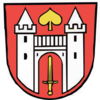Mittelhausen (Erfurt)
|
Mittelhausen
State capital Erfurt
|
|
|---|---|
| Coordinates: 51 ° 2 ′ 27 ″ N , 11 ° 0 ′ 19 ″ E | |
| Height : | 168 m above sea level NN |
| Area : | 5.14 km² |
| Residents : | 1085 (December 31, 2016) |
| Population density : | 211 inhabitants / km² |
| Incorporation : | July 1, 1994 |
| Postal code : | 99095 |
| Area code : | 0361 |
|
Location of Mittelhausen in Erfurt
|
|
Mittelhausen is a district of the city of Erfurt in Thuringia and is about eight kilometers north of the city center.
geography
Mittelhausen is located north of the Erfurt city center on the narrow Gera . The new federal motorway 71 runs past the southern edge of the town .

history
Excavations in the run-up to the construction of the A 71 motorway in 2001 and 2002 revealed that it was a settlement and burial site from the Neolithic to the time of the Thuringian Empire.
At the beginning of the 9th century Mittelhausen was first mentioned in a register of the goods lent by Archbishop Lullus († 786) of Mainz to the monastery of Hersfeld von Free as Midilhusun in imperial possession. Together with the neighboring Riethnordhausen , Mittelhausen formed a "smaller county" owned by the Landgraves of Thuringia. In 1152 a ministerial family named themselves after the place.
The place Mittelhausen acquired historical importance for Thuringia around 1130, when Landgrave Ludwig II. Mittelhausen was chosen as Supreme Dingstuhl of the Landgraviate , where he spoke right four times a year - on a court stage: "Auf dem Riethe zu Mittelhausen", on the meadow "Maspe" (Am Aspenbaum). The counts of the country were assessors . This institution was preserved for over 200 years and gained central importance as a regional peace court . The landgraves did not speak law here as territorial princes, but “under the spell of a king” as judges appointed by the German king . "The actual content of the landgrave dignity established by the German king consisted in the rule over this centrally located regional court". In 1250 and 1252, the Thuringian nobility had to swear peace to the state near Meitilishusen , and in 1307 the “unruly Erfurt” was summoned to the regional court. Only the Thuringian Count War 1342-1346 ended the work at this point.
The current church was built in 1504.
Mittelhausen and Riethnordhausen came to the Ernestine Electorate of Saxony when Leipzig was partitioned in 1485. From 1542 they belonged to the newly formed "Amt Ringleben ", which remained in the possession of the Ernestines after the Wittenberg surrender in 1547 and became part of the Duchy of Saxony-Weimar when Erfurt was partitioned in 1572 . After the death of Duke Wilhelm IV of Saxony-Weimar , the Ringleben office with its three locations was assigned to the newly created Duchy of Saxony-Eisenach in 1662 and in 1672 it was affiliated to the Großrudestedt office. From 1741 this belonged to Sachsen-Weimar-Eisenach . The place was assigned to the Weimar administrative district of the Grand Duchy of Saxony-Weimar-Eisenach in 1850 .
The court site is now (2011) nor to the northwest of the town available. A poor dirt road ("Am Denkmalsweg") leads there from the Mittelhausen / Nöda road, going left. A monument located in a small grove , in a dilapidated condition and right next to several gravel pits, is a reminder of this historic place. The memorial plaque on the obelisk has been removed, the sandstone littered with scratched “inscriptions”. After the gravel mining has been completed, a restoration of the monument is planned, which will then be located in the " Erfurt lake landscape ".
Population development
- 1843: 868
- 1910: 974
- 1939: 1300
- 1990: 1098
- 1995: 1113
- 2000: 1122
- 2005: 1136
- 2010: 1084
- 2015: 1049
economy
The economy of the place was characterized by agriculture. The large courtyards are evidence of this. Later, the mining and processing of the rich clay deposits in the Mittelhäuser corridor also gained economic importance and gave Mittelhaus residents their wages and bread. In addition, large mills were operated on the Gera. Today, the agricultural areas around Mittelhausen are mainly cultivated by UNI-Agrar, which is also one of the suppliers to the Erfurt dairy farm due to its dairy farming . From a former part of the VEG Saatzucht Zierpflanzen Erfurt (today the Leibniz Institute for Vegetable and Ornamental Plant Cultivation ), a gardener settlement has developed on 12 hectares, which continues the tradition of the Mittelhausen horticultural site . Gravel is mined on a large scale north of Mittelhausen .
West of Mittelhausen, between the local road to Kühnhausen and the A71, the book wholesaler Koch, Neff & Volckmar (KNV) has been building its new central warehouse since 2012.
Web links
literature
- Mittelhausen. In: Hans Patze , Peter Aufgebauer (Hrsg.): Handbook of the historical sites of Germany . Volume 9: Thuringia (= Kröner's pocket edition . Volume 313). 2nd, improved and supplemented edition. Kröner, Stuttgart 1989, ISBN 3-520-31302-2 , pp. 282-283.
Individual evidence
- ↑ Ingrid Burghoff: “Journey into history. Thuringia". Kartographischer Verlag Busche GmbH. Dortmund 1991. ISBN 3-88584-312-9 . P. 88
- ^ The district court district Großrudestedt in the digital collections of the University Library Weimar
- ^ Johann Friedrich Kratzsch : Lexicon of all localities of the German federal states . Naumburg, 1843.
- ↑ gemeindeververzeichnis.de
- ↑ Michael Rademacher: German administrative history from the unification of the empire in 1871 to the reunification in 1990. (Online material for the dissertation, Osnabrück 2006).
- ^ Thuringian State Office for Environment and Geology: Environment regional.
- ↑ Population of the city districts
- ↑ Construction of the media logistics center in Mittelhausen (Erfurt)



